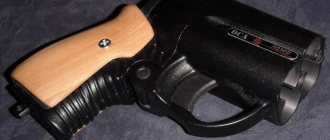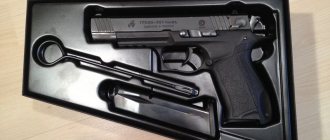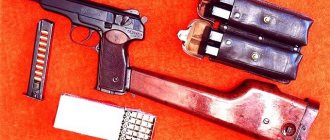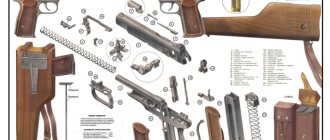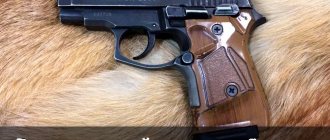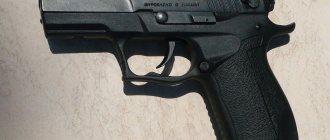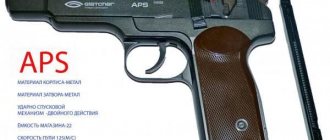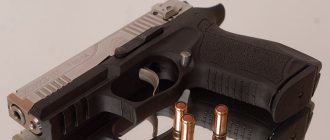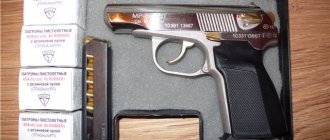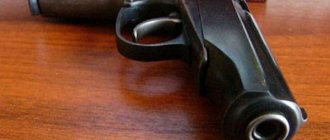Home | Weapons | Traumatic self-defense weapon - ooop | APS-M pistol
Stechkin APS-M traumatic pistol
The Stechkin APS-M traumatic pistol was produced by Vyatsko-Polyansky by converting it from APS combat pistols. To prevent firing in bursts, the parts responsible for automatic fire were dismantled in the pistol, and the trunnion of the transmission lever was cut off, which eliminates the installation of these parts at all. The barrel design consists of an external barrel simulator and an internal barrel simulator liner, pressed into each other and installed in an unrestricted pistol frame. There is only one protrusion in the channel of the barrel simulator, not counting the choke constriction of the muzzle. Despite the external barrel simulator and the internal liner being pressed into each other, during the firing process, when a rubber ball passing through the only protrusion of the barrel simulator liner creates a bending moment of force, a very small void is formed between the barrel simulator and the liner. But at the same time, the cartridge case has not yet been removed from the chamber, and the chamber is inflated, as a rule, in the upper part. Fortunately, it only happens once, but it stays forever.
This can be cured by polishing the top of the chamber at the breech. When fired, the pistol often tears rubber bullets, which can be treated by polishing the bullet entrance. During a shot, the pin securing the barrel simulator insert and the barrel simulator may “come out” a little, which will lead to the pistol jamming. Therefore, before starting operation, it makes sense to core the pin in order to prevent its shift. Unlike the conversion of part of the APS in the late 90s of the 20th century for the German police, the plant did not weld the bolt plane to limit the travel of the safety box, so the safety box moves to the position for firing bursts, but still fires single shots. The design of the magazine was changed, the capacity of which was reduced to 10 rounds by installing an insert in the magazine.
However, if desired, you can use original APS magazines for 20 rounds, or the feeder and feeder spring from them in the housing, removing the insert. To increase the muzzle energy to an acceptable level, it is highly recommended to polish the protrusion in the bore of the barrel simulator, as well as heat treat the barrel. However, it must be remembered that APS are poorly interchangeable with each other in terms of spare parts. The pistol is quite massive, but extremely light for its size. Despite the large dimensions of the weapon, I personally was pleasantly surprised by the comfort of the handle; at least the pistol “sat” perfectly in my hand. The pistol kit includes the pistol itself with two magazines, a passport for it, a box, so a wooden or thermoset plastic holster, and 20-round magazines, if desired, must be purchased separately. Unfortunately, the big disadvantage is its very high cost, going through the roof for 35,000 rubles. The production of the Stechkin APS-M pistol was discontinued in 2011.
Stechkin APS-M traumatic pistol with attached holster-butt
History of the Stechkin pistol
Igor Yakovlevich Stechkin, the developer of this model, had a natural talent as a gunsmith. He has about 70 developments and 40 inventions to his credit. Half of the samples he made are still in service today. But the most popular is APS.
This was Stechkin’s diploma work at the Tula Institute. The incident that happened to Stechkin during his defense is widely known. One of the professors examining him, having become acquainted with the operating diagram of the pistol, said that this model would not fire. Stechkin took out the prototype he had made and fired a shot at the ceiling. As a result, the commission gave him the highest score and commissioned the development of this weapon.
Having got a job at TsKB14, the young specialist completed the task within a year. The first automatic model was demonstrated in 1948.
After a while, after some modifications and testing, the pistol was put into service under the APS marking. And since 1952, large-scale production began.
APS can fire single rounds and bursts. At first it was intended for soldiers who were not entitled to a machine gun, and the PM was not enough in battle.
The APS was simple in design and maintenance, like the PM. But much more powerful due to the long barrel and more rounds in the magazine. In addition, it has a holster-butt, which is attached to the handle, which significantly increases the accuracy of the shot.
Due to the elongated barrel and excellent ballistics, the shot is much quieter, unlike the PM. And the installation of a tempo retarder made it possible to provide the APS with better controllability even during burst fire.
One of the main advantages of the Stechkin is the low recoil and tossing of the pistol when firing. This makes it possible to perform high-speed single shooting with high accuracy. And also control the amount of ammunition.
APS has a large resource. The operating time of certain models reached 50 thousand shots without deformation in the structure.
Despite the use of ammunition with low ballistic indicators, the APS has excellent shooting accuracy - better than that of the PM. Due to this, he gained popularity among employees of the OGPU, as well as other special forces.
The APS was recognized as one of the best pistols developed during the Soviet Union. Therefore, his story at first almost exactly repeats the fate of PM. And yet, in 1958, Stechkin production was stopped, and most of it was sent to warehouses.
This is due to the fact that during use, some of the advantages of Stechkin became disadvantages. Thus, due to the bulky butt holster, which increases the accuracy of the shot, it was inconvenient to wear the APS. The weight of the weapon is 1.03 kg, plus the weight of the holster is 0.55 kg. You need to get used to the APS: the slightly tilted handle does not allow you to shoot offhand.
As a result, for staff officers the pistol was very large, but for combat officers it was low-powered; they needed a full-fledged machine gun. And yet it remained in service until 1981.
The model was actively sold to foreign countries. APS, for example, was presented as a gift to the leaders of friendly states. Thus, the APS was the personal pistol of Che Guevara and Fidel Castro.
Tactical and technical characteristics of Stechkin
— Designer: Stechkin, Igor Yakovlevich — Developed: 1948 — Manufacturer: Vyatsko-Polyansky Machine-Building Plant — Years of production: 1951—1958
Stechkin weight
— 1.02 kg (without cartridges and holster-butt); 1.22 kg (equipped without holster-stock); 0.56 kg (holster-stock)
Stechkin sizes
— Length, mm: 225 (without holster-butt); 540 (with holster-butt) — Barrel length, mm: 140 — Height, mm: 150
Stechkin cartridge
— 9×18 mm PM
Stechkin caliber
— 9 mm
Stechkin's rate of fire
- 700-750; 40/90 (combat rate of fire when firing single/burst) rounds/min
Stechkin bullet speed
— 340 m/s
Stechkin sighting range
— 200 meters
Stechkin magazine capacity
— box-shaped double-row magazine for 20 rounds
Sight: open drum type (range settings: 25, 50, 100 and 200 m) Operating principles: blowback.
Design
The MP-355 Stechkin traumatic weapon is manufactured by Izhmekh; it is a remake of the popular APS combat pistol. The model fires 9 mm rubber cartridges. The barrel is rigidly fixed to the frame. There are several “teeth” in the barrel channel, which prevent the firing of live ammunition. One “tooth” is located below the chamber, the other is on top 1 cm from it, then the smooth bore begins.
Trunk
A long, smooth section of the barrel bore has a positive effect on the power and accuracy of the weapon. The barrel at the end has a narrowing of 6 mm. Automation operates on the principle of recoil during free movement of the bolt frame. The double trigger has a trigger type; you can fire with pre-cocking or self-cocking. The trigger is quite tight and has a long stroke.
There is no queue mode. The flag-type fuse is located on the left side of the bolt frame.
Shop
The pistol is fed with ammunition from a standard clip of a Stechkin pistol, but the MP-355 is equipped with magazines that are equipped with cartridge limiters of up to 10 pieces. The stopper appears as a depression in the rear of the holder, approximately 0.8 mm, which makes it relatively easy to remove. Or installing a native APS clip for 20 rounds of ammunition.
The clip latch is located at the bottom of the handle. The pistol is equipped with a sector sighting device. Advantages of the MP-355, in contrast to the APS-M: the tooth under the retarder lever on the bolt frame is not removed, and instead of 2, one trunnion is filed.
Such injuries as Leader, Naganych, Kombrig, PM are purchased, as a rule, as working historical models of pistol models and are rarely used for self-defense. One of the reasons for this circumstance is that traumatic replicas of combat pistols were not created for concealed carry at all.
The same applies to the MP-355 weapon, but today comfortable holsters are being made for use by Stechkin by intelligence officers, and when choosing the right holster, even such a large injury can be carried concealed.
The MP-355 model is quite large, but, like a real Stechkin pistol, it is relatively light in weight for its size. Like its combat counterpart, the MP-355 is easy to maintain due to its design features and has a long service life. Stechkin's main advantage is his main base.
A review and shooting of the Stechkin traumatic pistol can be seen in this video:
general information
The APS traumatic pistol appeared on the Russian market in 2007. At that time, the traumatic weapon began to acquire acceptable power, which would simply be enough for effective self-defense. In those same years, traumatic cartridges also became significantly better: now they contained enough gunpowder so that the bullet had time to gain good speed in the barrel.
There were very different ideas about the traumatic Stechkin. Some fell in love with it at first sight, others were significantly dissatisfied with the cost of the pistol, which was in the range of 45-60 thousand rubles. This cost was incomparable with other traumatic pistols that were popular at that time.
But the consumer did not have to complain, because this was the only adaptation of this military weapon for trauma. It turns out that this weapon is not for everyone. You have to get used to it, it’s huge. Most likely, it is better not to use it for self-defense, but for sport shooting it is the best option.
custom_block(1, 52877809, 7761);
Advantages and disadvantages of the model
High accuracy and accuracy
"Threatening" appearance and historical value
Available spare parts and service repairs, unlike imported models
All components and mechanisms that were manufactured during the USSR have a high durability
The shooting power is quite enough for self-defense
Relatively light for its size
A “congenital” defect of the trunk canal, which leads over time to its swelling. Can be corrected by heat treatment and polishing
Large size - the weapon can be used for fun or sport shooting, but it is inconvenient for daily carry
Tight trigger pull, which came from a combat pistol
Frequent ruptures of cartridges in the barrel channel
High cost of the pistol
Small magazine capacity
How can you come to a conclusion?
If it is important for you that a traumatic weapon looks brutal and beautiful, then you can safely take this pistol. If you want to purchase a good weapon for constant sport shooting, this is a good option for you.
But if you are specifically looking for a weapon to constantly carry for the purpose of self-defense, then think a couple of times before taking the Stechkin. Maybe you can't get used to its size and will get tired of constantly carrying this pistol. As a result, we can come to the conclusion that this weapon is high quality, but not for everyone.
Stechkin equipment
The basic package includes:
- The gun itself.
- Butt holster.
- Two clips.
- Cleaning kit.
- Instructions and passport for the weapon.
Today, when you can only buy a Stechkin traumatic pistol “by hand”, the delivery package is discussed with the seller in person.
Dismantling Stechkin
Partial disassembly and regular cleaning are mandatory for the owner of any type of weapon.
The main steps are as follows:
- Get the clip.
- Make sure there is no cartridge in the chamber.
- Cock the hammer, lower the trigger guard.
- Pull the bolt carrier back, lift the rear up, move the bolt forward and remove it from the barrel.
- Remove the return spring.
Next, work is carried out to clean and lubricate the weapon, and assembly is carried out in the reverse order.
Disassembly and tuning of the Stechkin traumatic pistol can be seen in this video:
Getting permission
Traumatic pistols are relatively affordable and quite effective for self-defense. Due to gun laws, a pistol must be licensed to purchase and use.
To obtain a purchase license, you need to collect the following list of documentation:
- Application form to the district Ministry of Internal Affairs for a license.
- Document confirming completion of courses on the rules of using and handling a pistol.
- A check that confirms payment for the services of licensing authorities and the production of a form for the right to use a pistol.
- Report from the local police officer on checking the correct storage of weapons (installation of a gun safe, security of locks).
- Certificate of good conduct.
- A medical report confirming the absence of contraindications for obtaining a pistol permit (given at the clinic at your place of residence).
All documentation for obtaining a license to purchase trauma equipment is submitted to the licensing authority of the Ministry of Internal Affairs at the place of residence. The employee who accepts the documents is required to give a notification coupon, which includes the date of receipt and number. The submitted application is reviewed within 2 weeks.
If the licensing department makes a positive decision, then within one month, if you have a civil passport, permission is given to purchase a traumatic pistol. Otherwise, a justified refusal will be sent.
The range of pistols is large. When purchasing, it is best to choose a weapon that is reliable, easy to maintain and operate, for example, a Stechkin pistol. The purchased weapon must be submitted for shooting within 14 days.
At the same time, the following documentation is submitted to the Ministry of Internal Affairs:
- Shot cartridges, which are sealed in special packaging and accompanied by accompanying documents (if the cartridges are provided by the manufacturing company).
- A copy of the permit to purchase a weapon with the store’s note about the sale.
- Application form for permission to store and use.
- Receipt for payment of the state fee for registering a pistol.
- Two 3x4 photos.
- An insurance policy that is issued when obtaining permission to purchase a pistol.
Failure to comply with the rules for wearing traumatic clothing may result in an administrative fine, and in some cases is a reason for criminal liability.


